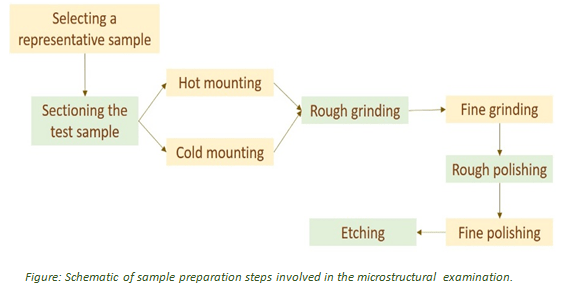This set of Manufacturing Engineering Multiple Choice Questions & Answers (MCQs) focuses on “Non-Destructive Testing”.
1. What is first step involved in the process of preparing test sample for microstructural examination?
a) Rough polishing
b) Fine grinding
c) Fine polishing
d) Etching
View Answer
Explanation: Fine grinding involves the use of abrasive silicon carbide, to get a flat surface, that is nearly free of the disturbed or deformed scratches which were introduced in the previous sample preparation step. For reference, the sample preparation steps are depicted in the below schematic:

2. Which of the following compound is used for fine polishing?
a) Aluminum oxide
b) Nitric oxide
c) Silicon carbide
d) Iron oxide
View Answer
Explanation: Powder form of aluminum oxide is used for fine polishing process. It is surface treatment process.
3. Etching of specimen is done to achieve ___________
a) Visible grain boundary
b) Invisible grain boundary
c) Toughness
d) Hardness
View Answer
Explanation: Etching is done to obtain visible grain boundary. It is a surface treatment process.
4. What is the average grain diameter (in mm) for the grain size ASTM grain size 12?
a) .0066
b) .0078
c) .0021
d) .0056
View Answer
Explanation: According to ASTM standard E1112, ”standard test methods for determining average grain size”:
n = 2G-1, where ‘G’ is the grain size number and ‘n’ represents the average number of grains per square inch at a magnification of 100X. Upon calculations one can deduce that:
Average Grain diameter (d, in mm) = \(\frac{1}{\sqrt{\frac{n×10^4}{645}}}\)
Given ASTM grain size 12, thus, n = 212-1 = 211 = 2048
Therefore, average grain diameter = \(\frac{1}{\sqrt{\frac{2048×10^4}{645}}}\) = 0.0056 mm.
5. Equipment used for inspection of inside portion of hollow chamber or narrow tube is known as ___________
a) Endoscope
b) Telescope
c) Borescope
d) Flexiscope
View Answer
Explanation: Borescope is used for visual of inside portion of the hollow chamber.
6. What is the value of average number of grains in per square inch for ASTM 11?
a) 2048
b) 1024
c) 6
d) 5
View Answer
Explanation: According to ASTM standard E1112, ”standard test methods for determining average grain size”:
n = 2G-1, where ‘G’ is the grain size number and ‘n’ represents the average number of grains per square inch at a magnification of 100X.
Given ASTM grain size 12, thus, n = 211-1 = 210 = 1024.
7. Which of the following property will be more in fine grained structure?
a) Ductility
b) Corrosion resistance
c) Creep resistance
d) Hardness
View Answer
Explanation: Finer the grain size (lower the grain size), more is the number of grain boundaries, thus more is the yield strength, thus more is the ductility. This is the reason why we can easily draw a fine-grained structure into wires.
8. Which of the following property will be more in coarse grain structure?
a) Ductility
b) Corrosion resistance
c) Hardness
d) Toughness
View Answer
Explanation: Grain boundaries are susceptible to corrosion. Coarse grain structure has less grain boundaries, thus has greater corrosion resistance.
9. Which of the following penetrating liquid is used in a liquid penetration test?
a) Water
b) Chlorine based solvent
c) Petroleum based carrier fluid
d) Fluorine based solvent
View Answer
Explanation: In liquid penetration test, either petroleum-or-water based carrier fluids are used as solvents or cleaners according to the type of penetrant used. Petroleum based carrier fluid is used as penetrating liquid in liquid penetration test along with fluorescent red colour dye for visible light.
10. Which of the following non destructive testing is used to detect change in composition of any material?
a) Liquid penetration test
b) Ultrasonic test
c) Eddy current test
d) Radiography
View Answer
Explanation: Radiography enables us to detect the change in composition. X-rays or γ-rays are used in radiography technique.
Sanfoundry Global Education & Learning Series – Manufacturing Engineering.
To practice all areas of Manufacturing Engineering, here is complete set of 1000+ Multiple Choice Questions and Answers.
If you find a mistake in question / option / answer, kindly take a screenshot and email to [email protected]
- Check Mechanical Engineering Books
- Check Manufacturing Processes I Books
- Practice Mechanical Engineering MCQs
- Practice Metallurgical Engineering MCQs
- Apply for Metallurgical Engineering Internship
